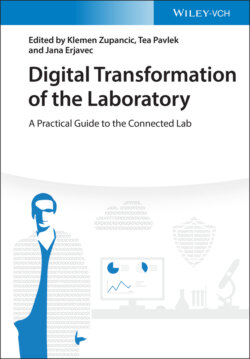Читать книгу Digital Transformation of the Laboratory - Группа авторов - Страница 15
1.2.2 Process
ОглавлениеThe lab processes, or “how” science gets done in the LotF, will be dominated by robotics and automation. But there will be another strong driver which will force lab processes and mindsets to be different in 5–10 years time: sustainability. Experiments will have to be designed to minimize the excessive use of “noxious” materials (e.g. chemical and biological) throughout the process and in the cleanup once the experiment is complete. Similarly, the use of “bad‐for‐the‐planet” plastics (e.g. 96/384/1536‐well plates) will diminish. New processes and techniques will have to be conceived to circumvent what are standard ways of working in the lab of 2020. In support of the sustainability driver, miniaturization of lab processes will grow hugely in importance, especially in research, diagnostic, and testing labs. The current so‐called lab on a chip movement has many examples of process miniaturization [9]. Laboratories and plants that are focused on manufacturing will continue to work at scale, but the ongoing search for more environmentally conscious methods will continue, including climate‐friendly solvents, reagents, and the use of catalysts will grow evermore important [10]. There will also be a greater focus on better plant design. For example, 3D printing [11] could allow for localization of manufacturing processes near to the point of usage.
In the previous paragraph, we refer to “research, diagnostic, and testing labs” and to manufacturing “plant.” We believe there is a fundamental difference between what we are calling hypothesis‐ and protocol‐driven labs, and this is an important consideration when thinking about the LotF. The former are seen in pure research/discovery and academia. The experiments being undertaken in these labs may be the first of their kind and will evolve as the hypothesis evolves. Such labs will embrace high throughput and miniaturization. Protocol‐driven labs, where pure research is not the main focus, include facilities such as manufacturing, diagnostic, analytical, or gene‐testing labs. These tend to have a lower throughput, though their levels of productivity are growing as automation and higher quality processes enable ever higher throughput. In these labs, reproducibility combined with robust reliability is key. Examples in this latter area include the genomic screening and testing labs [12, 13], which have been growing massively in the past few years. For these labs the already high levels of automation will continue to grow.
Figure 1.2 Virtual and real design‐make‐test‐analyze (DMTA) concept.
In the hypothesis‐driven lab [14] with the strong driver of sustainability combined with the growth of ever higher quality artificial intelligence (AI) and informatics algorithms, there will be more in silico, virtual “design‐make‐test‐analyze” (vDMTA) and less, tangible Make and Test (see Figure 1.2). Fewer “real” materials will actually be made and tested, and those that are will be produced on a much smaller scale.
Finally, as labs get more sophisticated – with their high levels of automation, robotics, miniaturization, and data production (but with fewer staff) – combined with the need for those facilities to be both safe and sustainable, the concept of “laboratory as a service” (LaaS) will grow [15]. The LotF will not be a static, self‐contained, and single scientific area facility. It will be a blank canvas, as it were, in a large warehouse‐like facility or cargo container [16] which can be loaded up on demand with the necessary equipment, automation, and robotics to do a contracted piece of lab work. That piece of work might be a chemical synthesis or a cell‐based pharmacological assay one day, and an ex vivo safety screen in the same area the next day. The key will be use of a modular design supported by fully connected devices.
